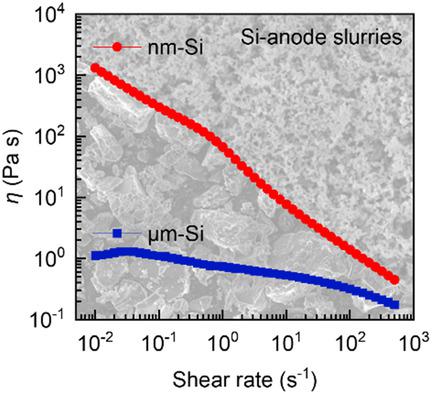当前位置:
X-MOL 学术
›
Energy Technol.
›
论文详情
Our official English website, www.x-mol.net, welcomes your feedback! (Note: you will need to create a separate account there.)
Micro versus Nano: Impact of Particle Size on the Flow Characteristics of Silicon Anode Slurries
Energy Technology ( IF 3.8 ) Pub Date : 2020-04-23 , DOI: 10.1002/ente.202000056 Rassmus Andersson 1 , Guiomar Hernández 1 , Kristina Edström 1 , Jonas Mindemark 1
Energy Technology ( IF 3.8 ) Pub Date : 2020-04-23 , DOI: 10.1002/ente.202000056 Rassmus Andersson 1 , Guiomar Hernández 1 , Kristina Edström 1 , Jonas Mindemark 1
Affiliation

|
Silicon is interesting for use as a negative electrode material in Li‐ion batteries due to its extremely high gravimetric capacity compared with today's state‐of‐the‐art material, graphite. However, during cycling the Si particles suffer from large volume changes, leading to particle cracking, electrolyte decompositions, and electrode disintegration. Although utilizing nm‐sized particles can mitigate some of these issues, it would instead be more cost‐effective to incorporate μm‐sized silicon particles in the anode. Herein, it is shown that the size of the Si particles not only influences the electrode cycling properties but also has a decisive impact on the processing characteristics during electrode preparation. In water‐based slurries and suspensions containing μm‐Si and nm‐Si particles, the smaller particles consistently give higher viscosities and more pronounced viscoelastic properties, particularly at low shear rates. This difference is observed even when the Si particles are present as a minor component in blends with graphite. It is found that the viscosity follows the particle volume fraction divided by the particle radius, suggesting that it is dependent on the surface area concentration of the Si particles.
中文翻译:

微米与纳米:粒径对硅阳极浆料流动特性的影响
硅作为锂离子电池的负极材料非常有趣,这是因为与当今最先进的石墨材料相比,硅具有极高的重力容量。但是,在循环过程中,Si颗粒的体积变化很大,导致颗粒破裂,电解质分解和电极崩解。尽管利用纳米尺寸的颗粒可以缓解其中的一些问题,但是在阳极中加入微米级的硅颗粒会更具成本效益。在此表明,Si颗粒的尺寸不仅影响电极循环性能,而且对电极制备过程中的加工特性具有决定性的影响。在包含μm-Si和nm-Si颗粒的水性浆料和悬浮液中,较小的颗粒始终具有较高的粘度和更显着的粘弹性,特别是在低剪切速率下。即使当Si颗粒在与石墨的混合物中以微量成分存在时,也观察到这种差异。发现粘度遵循颗粒体积分数除以颗粒半径,表明其取决于Si颗粒的表面积浓度。
更新日期:2020-07-02
中文翻译:

微米与纳米:粒径对硅阳极浆料流动特性的影响
硅作为锂离子电池的负极材料非常有趣,这是因为与当今最先进的石墨材料相比,硅具有极高的重力容量。但是,在循环过程中,Si颗粒的体积变化很大,导致颗粒破裂,电解质分解和电极崩解。尽管利用纳米尺寸的颗粒可以缓解其中的一些问题,但是在阳极中加入微米级的硅颗粒会更具成本效益。在此表明,Si颗粒的尺寸不仅影响电极循环性能,而且对电极制备过程中的加工特性具有决定性的影响。在包含μm-Si和nm-Si颗粒的水性浆料和悬浮液中,较小的颗粒始终具有较高的粘度和更显着的粘弹性,特别是在低剪切速率下。即使当Si颗粒在与石墨的混合物中以微量成分存在时,也观察到这种差异。发现粘度遵循颗粒体积分数除以颗粒半径,表明其取决于Si颗粒的表面积浓度。


























 京公网安备 11010802027423号
京公网安备 11010802027423号